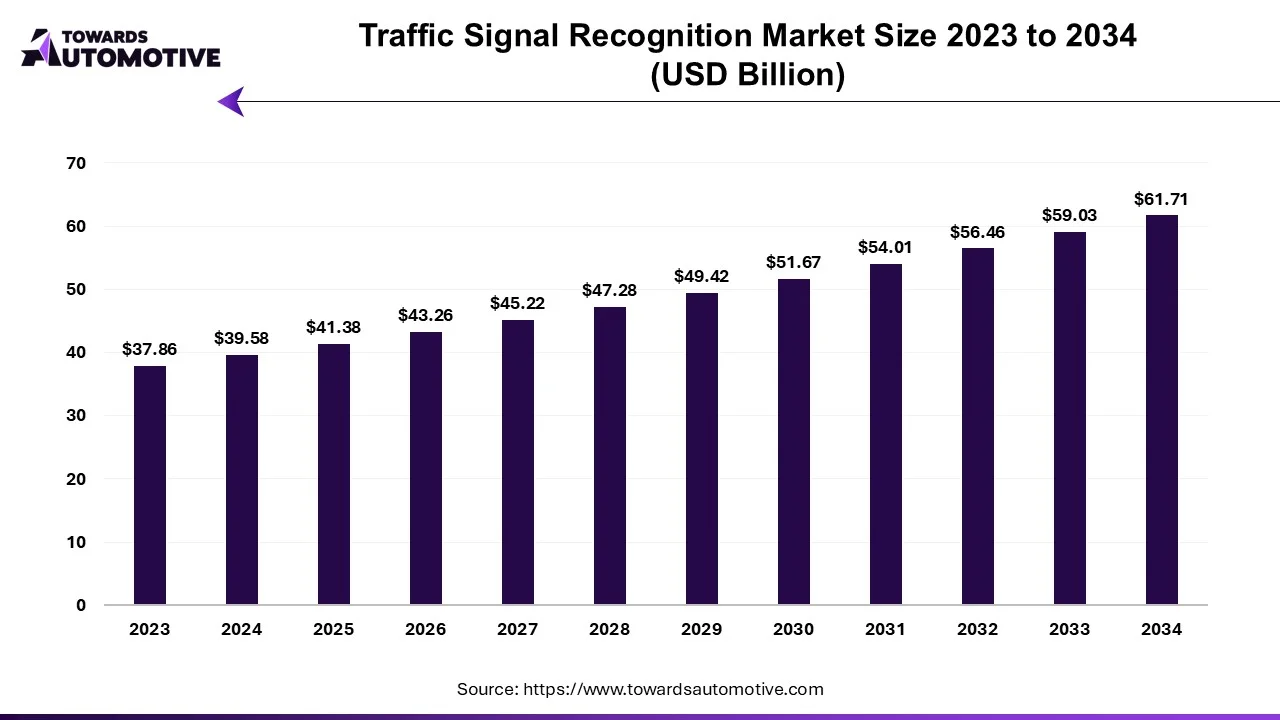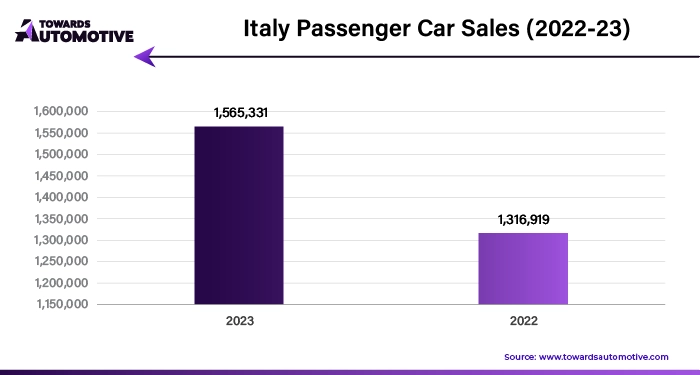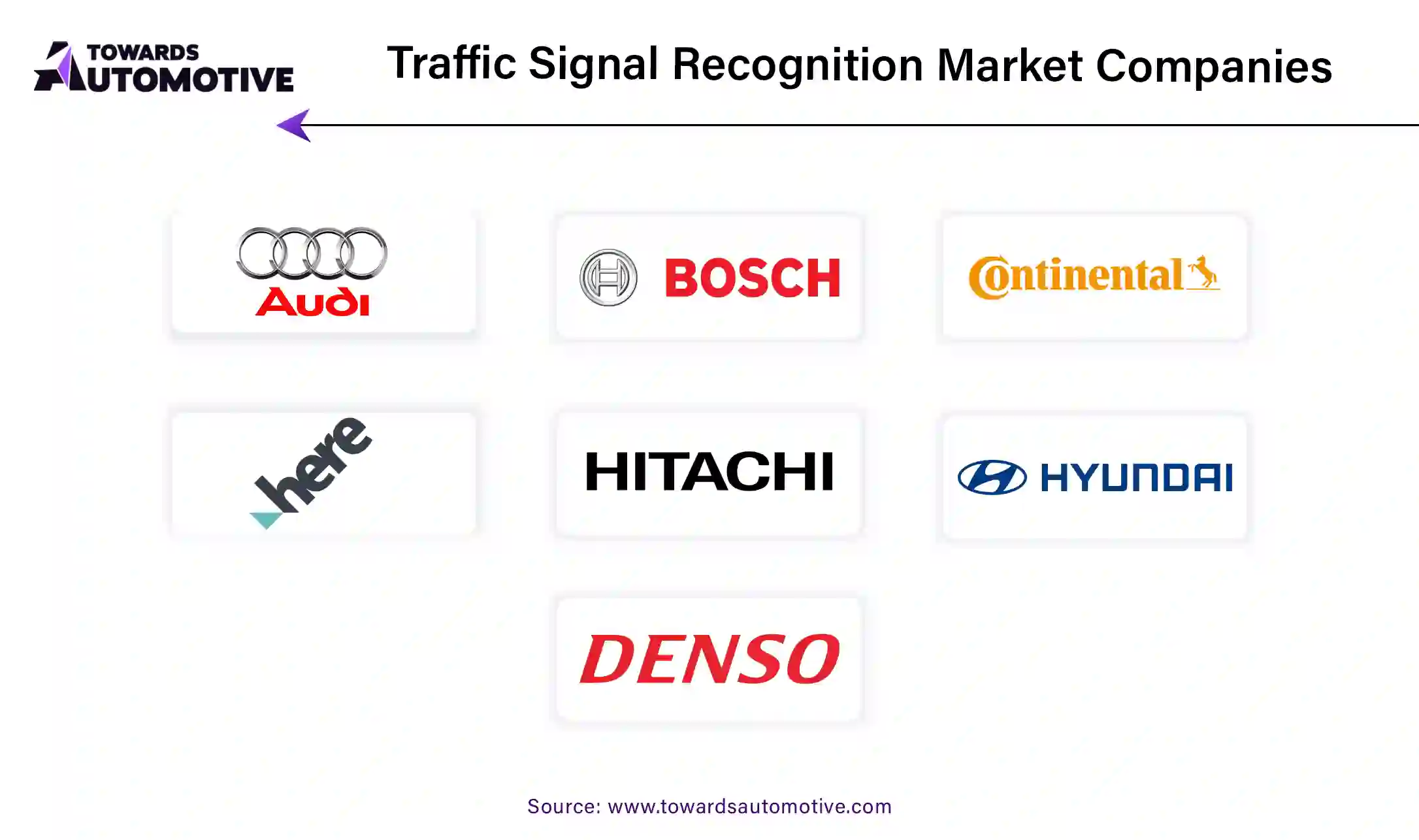September 2025
The global traffic signal recognition market is forecasted to expand from USD 41.38 billion in 2025 to USD 61.71 billion by 2034, growing at a CAGR of 4.54% from 2025 to 2034.

Unlock Infinite Advantages: Subscribe to Annual Membership
The traffic signal recognition market is rapidly evolving as advancements in automotive technology, particularly in the realm of driver assistance systems, gain momentum. Traffic signal recognition refers to the ability of a vehicle to detect and interpret traffic signals, such as stop signs, traffic lights, and other road signs, using sensors, cameras, and artificial intelligence (AI). This technology is a key component of advanced driver-assistance systems (ADAS) and autonomous vehicles, providing real-time information to the driver or the vehicle’s control systems to enhance safety and traffic flow.
The growing adoption of electric and autonomous vehicles, combined with increasing demand for connected cars, has significantly contributed to the expansion of the traffic signal recognition market. Governments and regulatory bodies worldwide are also promoting safer driving environments through stringent safety regulations, which is further accelerating the demand for intelligent systems like traffic signal recognition. These systems aim to improve road safety by minimizing human error, ensuring better compliance with traffic laws, and enhancing overall vehicle control.
The technology is also essential in the context of smart cities, where traffic infrastructure is becoming more integrated with digital solutions to optimize road usage and reduce congestion. The increasing focus on reducing traffic accidents and fatalities, especially in urban areas, is a primary driver for the market. As traffic signal recognition technology continues to evolve, it holds the potential to play a crucial role in the future of transportation, contributing to safer, smarter, and more efficient road networks globally.
AI plays a pivotal role in the traffic signal recognition market by enabling vehicles to understand and interpret traffic signals in real time, enhancing the overall efficiency and safety of advanced driver-assistance systems (ADAS). Through the use of machine learning, computer vision, and deep learning algorithms, AI helps vehicles process data from cameras and sensors to accurately detect and interpret various traffic signals, such as stop signs, traffic lights, and speed limit signs.
The integration of AI allows traffic signal recognition systems to continuously improve their accuracy and reliability. AI algorithms can be trained to recognize a wide variety of traffic signals across different environments, taking into account various factors like lighting conditions, weather, and the positioning of the signals. This adaptability is critical, as traffic signals may differ in appearance across regions, and conditions such as fog, rain, or glare can obscure visibility.
Furthermore, AI in traffic signal recognition can help reduce the likelihood of human error and improve the reaction time of drivers or autonomous vehicles. AI systems can instantly alert drivers about upcoming signals, provide visual or auditory cues, and even autonomously adjust the vehicle’s speed or position based on the detected signals. In fully autonomous vehicles, AI-powered traffic signal recognition systems can facilitate seamless navigation through intersections without human intervention.
The growing demand for safety features in vehicles is a significant driver of the traffic signal recognition market. As consumers and regulators place more emphasis on vehicle safety, automakers are integrating advanced technologies that enhance the overall driving experience and reduce the risk of accidents. Traffic signal recognition is a crucial component of these safety features, as it enables vehicles to detect and respond to traffic signals in real-time, ensuring safer navigation through intersections and busy roads.
This increasing demand for safety systems is fueled by the need to mitigate human error, which is a major factor in road accidents. By incorporating traffic signal recognition systems, vehicles can automatically identify and react to traffic signals, reducing the chances of drivers missing stop signs, traffic lights, or making unsafe maneuvers. Additionally, traffic signal recognition is essential for enhancing advanced driver assistance systems (ADAS), which include features like automatic emergency braking, adaptive cruise control, and lane-keeping assist. These systems work together to prevent collisions and provide a safer driving environment.
As governments and regulatory bodies introduce stricter safety regulations, automakers are compelled to meet these standards by adopting technologies like traffic signal recognition. Furthermore, consumer preferences for vehicles equipped with the latest safety technologies are driving automakers to incorporate these features into their product offerings. As a result, the growing demand for safety features directly contributes to the expansion and development of the traffic signal recognition market, pushing the industry toward more innovative, reliable, and efficient solutions to improve road safety.
The traffic signal recognition market faces several restraints, including high implementation costs and technical challenges. Integrating advanced systems into existing infrastructure can be expensive, especially in regions with outdated traffic management systems. Additionally, the technology's effectiveness depends on factors like camera quality, lighting conditions, and environmental variables, which can lead to reliability issues. Data privacy concerns also pose challenges, as the systems collect real-time data from public roads, raising issues regarding surveillance and data security.
The rising adoption of autonomous vehicles (AVs) presents significant opportunities for the traffic signal recognition market. As AVs continue to gain traction, there is an increasing need for advanced technologies that enable these vehicles to interact seamlessly with their environment. Traffic signal recognition is crucial for AVs to understand and respond to traffic signals in real-time, ensuring safe and efficient navigation. The ability to detect and interpret signals such as stoplights, turn signals, and lane markings is a key component of the autonomous driving experience.
As more automakers and tech companies invest in autonomous vehicle development, the demand for reliable traffic signal recognition systems grows. This trend is further amplified by advancements in machine learning, computer vision, and sensor technologies, which enhance the accuracy and reliability of these systems. Moreover, the push for smart cities and intelligent transportation infrastructure is accelerating the integration of traffic signal recognition solutions into urban environments, further expanding market opportunities.
The rise in AV adoption also aligns with regulatory shifts, as governments implement stricter safety standards for self-driving cars, creating additional demand for traffic signal recognition technology to ensure compliance. Overall, the increasing reliance on autonomous vehicles opens new avenues for growth in the traffic signal recognition market, driving innovation and further investments in this space.
The hardware segment held a dominant share of the market. The hardware segment plays a significant role in driving the growth of the traffic signal recognition market by providing the necessary infrastructure and components to enable accurate and reliable signal detection. Key hardware elements, such as cameras, sensors, and processing units, are integral to the functionality of traffic signal recognition systems. High-definition cameras and advanced sensors, such as LiDAR and radar, are designed to capture detailed images and data about the vehicle’s surroundings, including traffic signals, road signs, and other essential objects.
The growth of the hardware segment is fueled by advancements in sensor technologies, which have become more precise and cost-effective. This allows for better detection of traffic signals in various environmental conditions, such as low visibility, harsh lighting, and weather-related challenges. Additionally, the development of high-performance processing units is crucial in enabling real-time data analysis and reducing latency, ensuring that vehicles can respond promptly to detected signals.
The increasing demand for Advanced Driver-Assistance Systems (ADAS) and autonomous driving technologies also drives the growth of the hardware segment. As these technologies rely on traffic signal recognition systems to enhance vehicle safety and navigation, the need for advanced hardware components becomes essential. Furthermore, hardware advancements help improve system accuracy, reduce errors, and ensure the smooth functioning of these systems.
| Year | Hardware - Cameras and image sensors | Hardware - LiDAR sensors | Hardware - Radar sensors | Hardware - Processing units/ECUs | Hardware - Display units | Hardware - GPS receivers | Software - Image processing algorithms | Software - Machine learning models | Software - Object detection software | Software - Neural network solutions | Software - Cloud-based platforms |
| 2024 | 0.36 | 3.97 | 0.46 | 2.17 | 6.73 | 2.22 | 1.26 | 6.38 | 14.86 | 0.07 | 1.09 |
| 2025 | 0.44 | 4.66 | 0.42 | 1.61 | 6.64 | 2.62 | 0.81 | 6.27 | 15.49 | 0.42 | 1.99 |
| 2026 | 0.43 | 5.52 | 1.08 | 1.19 | 6.54 | 1.95 | 0.82 | 5.94 | 16.80 | 0.72 | 2.26 |
| 2027 | 0.47 | 5.51 | 1.07 | 0.47 | 7.16 | 1.87 | 0.47 | 5.87 | 18.69 | 1.50 | 2.14 |
| 2028 | 0.44 | 5.66 | 1.85 | 0.44 | 6.74 | 2.45 | 1.05 | 5.84 | 18.74 | 1.16 | 2.90 |
| 2029 | 0.49 | 4.95 | 2.46 | 0.49 | 7.26 | 2.96 | 1.34 | 5.33 | 20.04 | 1.45 | 2.65 |
| 2030 | 1.37 | 5.26 | 2.13 | 0.50 | 7.73 | 2.70 | 0.77 | 5.92 | 20.21 | 1.49 | 3.58 |
| 2031 | 0.66 | 5.00 | 1.85 | 1.56 | 7.49 | 1.81 | 1.22 | 6.88 | 21.52 | 1.45 | 4.57 |
| 2032 | 0.69 | 4.88 | 1.43 | 2.03 | 7.68 | 2.20 | 1.42 | 6.51 | 22.41 | 1.94 | 5.28 |
| 2033 | 0.80 | 5.30 | 2.60 | 1.40 | 8.96 | 1.22 | 0.61 | 6.47 | 25.34 | 1.27 | 5.05 |
| 2034 | 0.61 | 5.69 | 2.13 | 2.09 | 8.65 | 1.17 | 1.63 | 6.80 | 26.61 | 1.78 | 4.55 |
The passenger vehicles segment led the industry. The passenger vehicles segment plays a crucial role in driving the growth of the traffic signal recognition market, as it represents a significant portion of the global automotive industry. With increasing emphasis on vehicle safety, advanced driving features, and the transition toward autonomous vehicles, the integration of traffic signal recognition systems has become essential in passenger vehicles. These systems allow vehicles to detect and respond to traffic signals, contributing to safer driving experiences and improved traffic management.
The growing adoption of Advanced Driver Assistance Systems (ADAS) in passenger vehicles is a major driver for the traffic signal recognition market. ADAS technologies, such as automatic braking, adaptive cruise control, and lane-keeping assist, rely heavily on accurate and real-time recognition of traffic signals to function effectively. Traffic signal recognition systems, when integrated with other ADAS features, enable vehicles to automatically adjust their speed, stop at red lights, or proceed through green lights without driver intervention.
Additionally, the push for autonomous vehicles is accelerating the demand for traffic signal recognition systems in passenger vehicles. Autonomous vehicles require robust systems to navigate through complex environments, including city streets with multiple traffic signals. As the market for fully autonomous vehicles grows, the need for accurate, reliable, and fast recognition of traffic signals becomes even more important.

North America dominated the traffic signal recognition market. The growth of the traffic signal recognition market in North America is primarily driven by the rising demand for autonomous vehicles, stringent safety regulations, and the increasing adoption of Advanced Driver Assistance Systems (ADAS). The shift towards autonomous vehicles is one of the most significant factors contributing to the demand for traffic signal recognition technology. Autonomous vehicles rely on precise and real-time information to navigate safely in urban environments, and traffic signal recognition plays a crucial role in ensuring these vehicles respond appropriately to traffic signals, enhancing road safety and supporting autonomous driving capabilities.
Stringent safety regulations in North America also play a pivotal role in driving market growth. Regulatory authorities, such as the National Highway Traffic Safety Administration (NHTSA), have mandated the inclusion of ADAS features in vehicles to improve road safety and reduce traffic-related fatalities. As a result, automakers are increasingly integrating technologies like traffic signal recognition into their vehicles to comply with these regulations.
Moreover, the growing adoption of ADAS across various vehicle segments is another key driver. ADAS technologies, including lane-keeping assist, automatic braking, and adaptive cruise control, work in conjunction with traffic signal recognition to improve vehicle safety. As consumers demand more advanced safety features, automakers are compelled to equip their vehicles with these systems, further accelerating the growth of the traffic signal recognition market in North America. Together, these factors are fueling the adoption of traffic signal recognition systems, making them an integral part of the evolving automotive landscape in the region.
Europe is expected to grow with the highest CAGR during the forecast period. In Europe, the growth of the traffic signal recognition market is significantly driven by infrastructure development, stringent safety regulations, and the rising adoption of smart city initiatives. The region’s focus on modernizing infrastructure, including the upgrade of traffic management systems, is creating an environment conducive to the integration of advanced technologies such as traffic signal recognition. These systems provide real-time data that helps in managing traffic flow more efficiently and safely, which is essential as cities grow and congestion increases.
Stringent safety regulations in Europe are another key factor driving market growth. European countries are known for their robust vehicle safety standards, and organizations like the European Union (EU) have mandated the implementation of various Advanced Driver Assistance Systems (ADAS) to enhance road safety. As a result, automakers are increasingly integrating traffic signal recognition technology into their vehicles to comply with safety norms, contributing to the growth of the market.
Additionally, the rise of smart city initiatives across Europe is creating significant opportunities for traffic signal recognition systems. These initiatives aim to develop sustainable, efficient, and connected urban spaces, where traffic management plays a crucial role in minimizing congestion, reducing emissions, and ensuring road safety. Traffic signal recognition systems are integral to the success of these initiatives as they provide the necessary data for smarter, more responsive traffic control. With the growing number of smart city projects, there is an increasing demand for advanced traffic management technologies, including traffic signal recognition, further driving the growth of the market in Europe.
| Year | North America | Europe | Asia-Pacific | Latin America | Middle East & Africa |
| 2024 | 0.99 | 18.78 | 9.76 | 3.26 | 6.78 |
| 2025 | 0.41 | 19.87 | 10.02 | 4.04 | 7.04 |
| 2026 | 0.52 | 20.28 | 9.89 | 4.60 | 7.96 |
| 2027 | 0.97 | 20.93 | 10.49 | 4.48 | 8.34 |
| 2028 | 1.64 | 20.67 | 11.27 | 4.56 | 9.13 |
| 2029 | 2.31 | 20.60 | 11.83 | 4.40 | 10.28 |
| 2030 | 2.94 | 21.38 | 12.55 | 4.05 | 10.75 |
| 2031 | 2.63 | 21.82 | 13.07 | 4.90 | 11.59 |
| 2032 | 2.49 | 22.76 | 14.31 | 4.82 | 12.07 |
| 2033 | 2.22 | 23.52 | 14.96 | 5.59 | 12.73 |
| 2034 | 1.40 | 25.69 | 16.03 | 5.14 | 13.45 |

By Component
By Vehicle Type
By Technology
By Application
By Region
September 2025
September 2024
March 2025
March 2025
We offer automotive expertise for market projections and customizable research, adaptable to diverse strategic approaches.
Contact Us